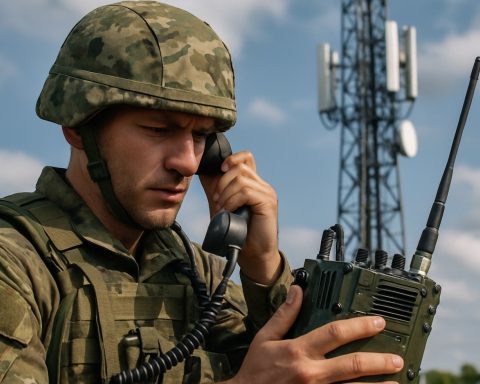- Intel faces challenges from competitors like TSMC and Samsung, with its stock reflecting past stagnation.
- Lip-Bu Tan, with a successful history at Cadence Design Systems, aims to rejuvenate Intel by focusing on an engineering-centric approach.
- Revitalization efforts include competitive AI solutions and nurturing Intel’s foundry business, amid collaborations with the U.S. government.
- Financial struggles are evident with a 2024 revenue dip to $53 billion and a substantial net loss of $18.8 billion.
- Capital expenditure cuts have delayed the Ohio foundry’s debut to 2030, creating cash flow concerns and investor skepticism.
- Tan’s strategic vision seeks to revive technical innovation and secure contracts to restore Intel’s semiconductor industry status.
- Intel’s future remains uncertain, with potential for recovery hinging on successful execution of Tan’s plans.
The sun-soaked shores of Silicon Valley witness a new chapter for Intel as Lip-Bu Tan steps into the limelight with a mandate to steer a floundering giant back to glory. Once a beacon of innovation, Intel has found itself eclipsed by formidable rivals like Taiwan Semiconductor Manufacturing Company and Samsung, and its stock is hauntingly reminiscent of its 1997 price—a sobering reminder of stagnant ambitions.
Intel, an emblem of America’s technological prowess, faces a crossroad. The journey toward reclaiming the semi-conductor throne is fraught with challenges, all eyes are on Tan, a seasoned maestro in the tech symphony, who is more than familiar with the industry’s crescendos and crescendos. With over two decades under his belt and a transformative tenure at Cadence Design Systems, where his stewardship saw the stock skyrocket by an astonishing 2,700%, expectations are sky-high.
But where does one even begin to revitalize a titan like Intel? For Tan, the path is clear: shed the layers that have bound innovative potential and hone in on an engineering-centric ethos that reinvigorates the company’s core strength. This technical renaissance includes an audacious pivot to competitive AI solutions, a move necessary after the underwhelming performance of the Falcon Shores AI accelerator. In tandem, Tan is nurturing the foundry business, envisioning a robust collaboration with the U.S. government to elevate domestic semi-conductor manufacturing.
However, one cannot disregard the stark financial terrain that awaits. Intel’s revenue dipped to $53 billion in 2024—a 2% slump from the previous year. Coupled with soaring costs and hefty restructuring charges, the net loss balloons to an eye-watering $18.8 billion, a stark contrast to 2023’s modest profit. Capital expenditure cuts have postponed the much-anticipated Ohio foundry, pushing its debut to a distant 2030. This scarcity of cash flow further erodes confidence among investors, underscoring the need for urgent financial rehabilitation.
Tan’s strategic vision may well catalyze a rebirth, but the road ahead is marred with uncertainty. Intel’s stock, trading at a mere fraction of its book value, dangles as a speculative treasure—a spark for the daring investor with an appetite for risk, tempered by patience.
A resurgence will demand not just a revival in technical innovation but also securing critical contracts that reaffirm Intel’s place in the semiconductor pantheon. As Tan charts his course amidst prevailing headwinds, only time will tell if Intel can rebuild itself and offer a glimmer of hope to its beleaguered shareholders. The industry waits with bated breath—can Intel script another champion’s tale?
Can Intel’s New Leadership Spark a Tech Renaissance? A Closer Look at the Road Ahead
Unpacking Intel’s Current Challenges
Intel’s journey to regain industry dominance is marked by significant hurdles, stemming from financial woes and increased competition. Let’s delve deeper into the complex landscape the company must navigate:
1. Stiff Competition: Intel’s primary competitors, TSMC and Samsung, have surged ahead with advanced process technologies, claiming a significant share of the semiconductor market. Intel needs to innovate rapidly to close this gap and regain leadership.
2. Financial Strain: In 2024, Intel faced a significant loss, with net revenue dropping to $53 billion and an $18.8 billion net loss. These financial challenges are compounded by delayed projects, such as the Ohio foundry, initially expected to boost domestic manufacturing capabilities.
3. Shift to AI Solutions: Intel’s AI strategy is critical, especially following the underperformance of the Falcon Shores AI accelerator. Revamping this strategy is essential to compete with emerging AI leaders like NVIDIA.
Insights & Predictions for Intel’s Future
– AI and Engineering Excellence: By focusing on its core engineering capabilities, Intel has the potential to advance its AI solutions. Exploring partnerships with AI-driven companies could yield transformative results.
– Foundry Business Expansion: Strengthening ties with the U.S. government could bolster Intel’s foundry business. This collaboration might mitigate risks associated with supply chain disruptions affecting global chip manufacturing.
– Stock Potential: Intel’s stock, currently undervalued, presents an opportunity for investors willing to bet on the company’s turnaround strategy. With the right leadership and innovative breakthroughs, the stock may see significant appreciation.
Real-World Use Cases and Market Trends
– Expanding AI Applications: Intel has the potential to impact sectors such as autonomous vehicles, healthcare AI, and data center solutions. By integrating cutting-edge AI technologies, Intel can tap into these burgeoning markets.
– Sustainability Initiatives: As sustainability becomes more critical in technology, Intel’s focus on green manufacturing could set it apart. Efforts to reduce carbon emissions and enhance energy efficiency will resonate with environmentally conscious consumers and investors.
Pros & Cons Overview
Pros:
– Experienced Leadership: Lip-Bu Tan’s track record at Cadence Design Systems is a testament to his capability to invigorate tech companies.
– Strategic AI Focus: Revamping AI initiatives could place Intel at the forefront of a growing industry sector.
– Potential Government Partnerships: Collaborations can provide a competitive edge and enhance domestic production capabilities.
Cons:
– Financial Instability: Without substantial financial restructuring, Intel may struggle to invest in necessary innovations.
– Delayed Projects: Postponed initiatives like the Ohio foundry represent missed opportunities in a rapidly evolving market.
Actionable Recommendations for Intel
1. Accelerate AI Development: Focus R&D efforts on AI innovations to capture emerging market demand.
2. Enhance Operational Efficiency: Implement cost-control measures and optimize manufacturing processes to improve fiscal health.
3. Strengthen Partnerships: Foster collaborations with both public and private sectors to mitigate supply chain risks and enhance domestic capabilities.
Conclusion
Intel stands at a pivotal juncture, with the potential for a remarkable comeback under Lip-Bu Tan’s leadership. However, achieving this renaissance demands strategic innovation, fiscal discipline, and effective collaboration. For investors and stakeholders, the journey promises both challenges and opportunities. Stay updated with Intel’s progress and potential growth avenues at Intel’s official site.







